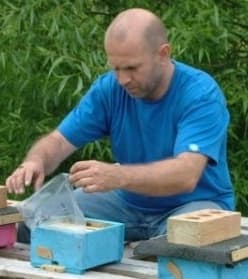Chris is a gardening writer and nature enthusiast. He graduated from Oxford Brookes University in 2022 with an MA in Psychology. Chris works with the Leeds Green Action Society, helping their food cooperative by growing various fruit and vegetables on their two allotments in Hyde Park, Leeds.
Reviewed By COLIN SKELLY

Colin is a Horticulturist and Horticultural Consultant with experience in a range of practical and managerial roles across heritage, commercial and public horticulture. He holds the Royal Horticultural Society’s Master of Horticulture award and has a particular interest in horticultural ecology and naturalistic planting for habitat and climate resilience.
Contributions From PETER BENEFER

As the Director of Benefers’ Bees, Peter is an expert at dealing with bees and also harvests and sells his own honey. He also runs his own YouTube channel where he promotes Benefers’ Bees with fun, educational videos.

Mariusz is from Goldendrops Bee Farm, an apiary that creates and sells products made from bees, including candles and honey. He also writes blog posts and creates videos for the site to keep readers informed about bees and the honey-making process.

Dave Goulson is the Professor of Biology at the University of Sussex and a specialist in the Ecology & Conservation of bees and other insects. He founded the charity the Bumblebee Conservation Trust in 2016 - which now has over 12,000 members - and he is the Director of The Buzz Club. Dave has published more than 300 scientific articles and several books on ecology and insect conservation, including Gardening For Bumblebees.

Karen Liebreich is a Gardener, Historian and Author whose works include ‘The Family Kitchen Garden’. She is the Director of Abundance London, a voluntary project aiming to reconnect people with nature - and also runs the Chiswick Flower Market. Karen was awarded an MBE in 2013 for services to horticulture and education.
IN THIS GUIDE
- Plants For Bees By Season
- Choosing The Right Flowers
- 1) Crocus
- 2) Phacelia
- 3) Sedum
- 4) Winter Flowering Honeysuckle
- 5) Lavender
- 6) Aquilegia
- 7) Helenium
- Trees for Bees
- 8) Apple Trees
- 9) Holly Trees & Bushes
- 10) Sophora japonica
- Bee-Friendly Herbs
- 11) Borage
- 12) Oregano
- 13) Chives
- 14) Rosemary
- So Get Planting For Bees…
- References
What could be more charming than sitting in your garden, watching the bees dance from flower to flower?
And while their gentle buzzing certainly adds to the natural ambience, bees are also an integral part of our ecosystem.
Bees are the world’s most important pollinators and we rely on them to pollinate up to a third of all the food we eat1Would we starve without bees? (2019, August 27). BBC Teach. Retrieved March 22, 2023, from https://www.bbc.co.uk/teach/would-we-starve-without-bees/zkf292p as well as 80% of flowering plants.2Why do we need bees? (2017, July 25). Friends of the Earth. Retrieved March 22, 2023, from https://friendsoftheearth.uk/nature/why-do-we-need-bees
Sadly, bees in the UK are under threat and, given how impactful they are on the success of our crops, losing them would be catastrophic.3Bees under siege from habitat loss, climate change and pesticides. (2019, May). WWF. Retrieved March 22, 2023, from https://www.wwf.org.uk/sites/default/files/2019-05/EofE%20bee%20report%202019%20FINAL_17MAY2019.pdf

Thankfully, as a gardener, you have the opportunity to make a difference.
Attracting bees into your garden is not only a huge benefit to your plants, but you can also rest assured knowing you are making a positive impact on the planet as a whole.
So if you have decided to embark on cultivating a bee-friendly, Earth-enhancing garden then this article is sure to set you on the right path.
We’ve studied the six years of research by the University of Sussex and the Goulson Lab (run by Professor of Biology and bee expert Dave Goulson) to help identify the plants bees love the most.4Plants for honey bees and other flower visitors. (2017, July 17). The Laboratory of Apiculture and Social Insects: University of Sussex. Retrieved March 22, 2023, from https://www.sussex.ac.uk/lasi/resources/plants
In short, their findings showed that Marjoram, Fleabane, Lamb’s Ear, Wallflowers, Buddleja, Verbena, Catmint and Borage are all among the flowers most appealing to bees.
Plants For Bees By Season
“The best way to attract bees to gardens is to grow plants, shrubs and trees that have flowers,” says Mariusz Chudy, the owner of Goldendrops Bee Farm.
Choosing a range of plants that flower in different seasons can benefit bees and pollinators across the entire year, rather than a short period in the year.
“I always encourage people to grow native plants where they can for bees, as there is good evidence that natives tend to attract more pollinating insects on average,” shares Bee Ecologist Dave Goulson.
“They also provide food plants for caterpillars, moths and other insects, which tend to be quite fussy with what they feed on, whereas non-natives tend not to be suitable foods for these.
“Thankfully, there are loads of plants that are attractive to bees and wildlife, including lots of pretty ones!”
Here are some of the top plants to grow for each season; choosing and growing just a few from each would be truly beneficial for your local wildlife:
| Season | Plants |
| Spring | Wallflowers Fleabane Aquilegia Holly Rosemary |
| Summer | Marjoram Phacelia Lavender Helenium Hollyhock Borage Chives |
| Autumn | Sedum Oregano Sephora Japonica |
| Winter | Crocus Winter Flowering Honeysuckle Apple Tree |
“My favourite plants are beautiful, robust, pollinator-friendly and can cope in the public realm without requiring watering,” shares Karen Liebreich, Gardener and Author.
We include more detail on some of these bee-friendly plants below, as well as a few of Dave’s videos to help in your quest. Let’s get to it!
Choosing The Right Flowers
As we’ve said, bees bring life to your garden and vice versa.
The nectar that bees forage for is packed with sugar which gives them the energy to stay busy. The pollen provides vital proteins and oil to keep them healthy.
“In short, bees prefer simple, open flowers,” says Peter Benefer, the Director of Benefers’ Bees.
“They see in the ultra violet spectrum and will go to flowers that give them the best reward in terms of nectar and pollen.
“Think of clothing that shows up in a nightclub, as that is what will be showing up in the bees’ eyes.”
It’s interesting to note that different species of bee have tongues of different lengths, so choosing a variety of flower shapes will allow more bees to enjoy your garden.
When it comes to choosing the right flowers a good, solid goal is to aim to cater for as many different species of bees as possible, as well as picking plants that flower in different seasons ensuring that you are providing for them all year round.
1) Crocus

A firm favourite among hairy-footed flower bees and queen bumblebees, these springtime flowers are the perfect start to their busy year.
Not only do these plants add a delightful splash of colour to your garden, but they provide vital shelter for bees who will often take refuge in them overnight.
If you’re lucky you should catch them leaving in the morning, laden with pollen.
2) Phacelia

According to Biologist Dave Goulson, Phacelia is “perhaps the single most attractive plant for bees on the planet.”
With a sweet scent, pretty blue flowers, and ferny leaves, this summer flowering plant produces an abundance of nectar and pollen, and is sure to keep your garden buzzing.
3) Sedum

This traditional classic flowers late into summer and early autumn.
Its large umbrella-shaped blooms are super accessible for hungry bees, making this a popular plant for several types of species.
4) Winter Flowering Honeysuckle

This highly fragrant plant sports gorgeous, tubular flowers making them perfect pitstops for winter-active bumble bees.
A native plant and intrepid climber whose flowers are followed by berries, which will also attract many species of birds.
5) Lavender

Bees adore lavender and this perennial plant grows back year after year.
What’s more, it flowers during the midsummer gap – a time where, surprisingly, there is little forage and honey bees are at their hungriest.
Lavender also repels moths, fleas, flies, and mosquitoes so this fragrant flower really is the gift that keeps on giving!
6) Aquilegia

Aquilegia (or ‘Grannys Bonnet’) is a herbaceous perennial that should return each year.
It usually flowers in late-spring or early summer when bees tend to be very active and has many beautiful and colourful varieties to choose from.
7) Helenium

Perennial flower Helenium (or ‘Sneezeweed’) is a firm favourite with bees of all sizes, including many smaller solitary bees.
While it should come back each year, it may need to be planted as an annual depending on which area of the UK you live in.
It should flower across 3-4 months in late summer and autumn.
Trees for Bees
If you are fortunate enough to have space, planting a tree is a wonderful, forward-thinking way to provide food and shelter for bees far into the future.
Equally, for those among you with a more modest-sized garden, ornamental fruit trees are an elegant alternative to keep the bees happy without compromising on valuable space!
8) Apple Trees

Not only does this tree bear one of the world’s most popular fruits, it is also irresistible to honey bees.
Whilst the bees keep your apple tree producing healthy fruits and seeds, the tree provides the bees with the energy and raw material they need to produce delicious honey: certainly one of nature’s sweetest treasures!
9) Holly Trees & Bushes

As well as its signature, spiky foliage, this festive plant also produces small white flowers in springtime which provide an abundant food source to help bees thrive.
Come autumn, its berries will also attract plenty of birds and other, wildlife keeping your garden brimming with life.
10) Sophora japonica

Also known as the Chinese Scholar Tree, this ornamental plant grows to around 1m in height.
With delicate pea-shaped flowers and feathery foliage, this miniature marvel flowers late into summer and early autumn, making it particularly helpful for bees.
Bee-Friendly Herbs
Not only are they great for our cooking, but lots of herbs are also loved by bees too.
These plants are also especially good for small gardens, so bear in mind that even if you only have a patio to work with, you can still encourage bees to visit you!
11) Borage

Nick-named “Bees Bread” because of its nectar-rich blue flowers, this magical little herb is a real hit with bees of many types!
Not only will it keep bees well-fed, you can also add its delectable, edible flowers to salads or freeze them in ice cubes to chill your summer cocktails.
12) Oregano

A fragrant and essential culinary herb, oregano is loved by honey bees, bumblebees, and a whole range of solitary bees.
It flowers in a range of pretty pink shades and the leaves can be added fresh to a wealth of dishes or, alternatively, can be frozen or dried to be used throughout the year.
13) Chives

This herb can be eaten fresh from the garden and is easy to grow from seeds.
For bees to benefit from chives however, you need to allow them to flower.
The purple florets provide plenty of nectar and are particularly well-loved by bumblebees.
14) Rosemary

A brilliant food source for bees with a long flowering season, this hardy and fragrant herb can also be harvested for its needles and added to a variety of meats, poultry, and fish.
Flowering in summer it provides plentiful nectar to keep your bees from buzzing off!
So Get Planting For Bees…
Hopefully we’ve given you plenty of ideas to give friendly bees a helping hand. And helping bees really does help your garden as well as our planet’s delicate ecosystem.
Regardless of the size of your garden, you can still make a real difference to the bees in your area.
According to Horticulturist Colin Skelly, “The artist Alexandra Daisy Ginsberg has produced an algorithm to produce a planting scheme that optimises the resource for bees (and other pollinators).
“There are versions at the Eden Project in Cornwall, Hyde Park and Berlin and the website of the project can produce a unique version for your own garden.”
You should also consider actively neglecting your garden and letting plants that are commonly considered weeds grow unabated. Studies have revealed that areas where gardens are left unkempt are often a haven for many species of bees.5Ashby, R. (2012, May 10). Keeping up with the Joneses harms Britain’s bees. University of Leeds. Retrieved March 22, 2023, from https://www.leeds.ac.uk/news/article/3198/keeping_up_with_the_joneses_harms_britains_bees
With so many plants to choose from it won’t be long until your garden is completely buzzing, in fact, we’re convinced it’s going to be the bee’s knees!
References
- 1Would we starve without bees? (2019, August 27). BBC Teach. Retrieved March 22, 2023, from https://www.bbc.co.uk/teach/would-we-starve-without-bees/zkf292p
- 2Why do we need bees? (2017, July 25). Friends of the Earth. Retrieved March 22, 2023, from https://friendsoftheearth.uk/nature/why-do-we-need-bees
- 3Bees under siege from habitat loss, climate change and pesticides. (2019, May). WWF. Retrieved March 22, 2023, from https://www.wwf.org.uk/sites/default/files/2019-05/EofE%20bee%20report%202019%20FINAL_17MAY2019.pdf
- 4Plants for honey bees and other flower visitors. (2017, July 17). The Laboratory of Apiculture and Social Insects: University of Sussex. Retrieved March 22, 2023, from https://www.sussex.ac.uk/lasi/resources/plants
- 5Ashby, R. (2012, May 10). Keeping up with the Joneses harms Britain’s bees. University of Leeds. Retrieved March 22, 2023, from https://www.leeds.ac.uk/news/article/3198/keeping_up_with_the_joneses_harms_britains_bees

